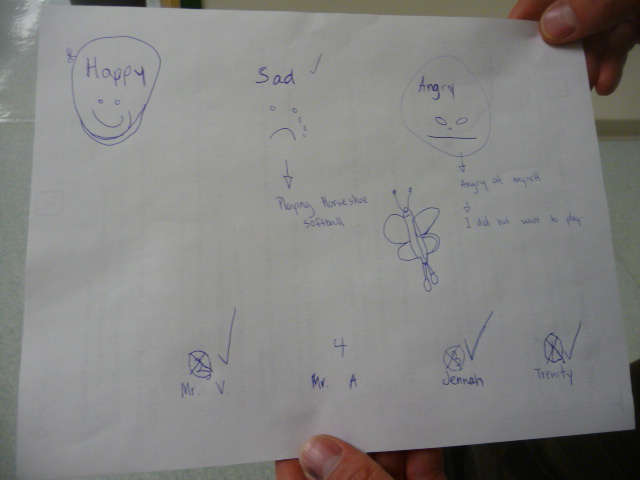 Social Anxiety Disorder Brochure
Social Anxiety Disorder Brochure
Artifact: This artifact is a self-help guide for parents, students and educators on where to find information on social anxiety disorders.
Reflection: This brochure was specifically developed to work with parents, students and other educators when my teaching commences and resources for students suffering from social anxiety are lacking. It is a means to assist parents of students with learning disabilities caused by social anxiety identify strategies on how to help their children cope and learn better.
____________________________________________________________
 Artifact: Drawing by kindergarten student in Nazko B.C.
Artifact: Drawing by kindergarten student in Nazko B.C.
Reflection: As with my reflection I mention above in standard 2 working with a mother to aid her son to boost his grades, this artifact reflects a situation I encountered in the absence of a parent being available. To give context to the situation I experienced in the absence of a parent being available, the above artifact was developed by a sponsor instructor working with a very young kindergarten student who became quiet and withdrawn from playing with the other students during a physical education lesson. I had been guiding the young students whom the student was playing in playing a form of softball that was suited for youngsters. The softball had been hit by another student and went past the student who later became quiet, something which appeared to trigger the quiet behaviour. Somewhat distressed by the young student switching off and out of interacting with anyone, the sponsor teacher and his teaching aid eventually came over, where upon I explained the situation. Not able to get to the bottom of things themselves, the teacher and his aid directed the student to a bench to sit things out until she was ready to return to th class. Lunch break came and went, as did the time; after about an hour and a half went by I saw the teacher communicating with the young student, at a certain point asked me over; he told me the student had something to tell: that she was sorry she made me worry. Naturally accepting what the young student said and relieved to see her go off to rejoin her classmates, I asked the instructor how he had got the student to come out her shell. He produced the above depiction, and told me that since the student could not write he asked her to draw what was the matter. The child drew that in the morning she was happy, but by the time the softball game had come about she had become sad. She wanted her mother and did not understand why she she could not go home, where she wished to be; however, the problem of her mother being at work and not available meant that myself and the other teachers had to intervene to do what we could to calm the child. Through the drawing and discussion the strategy worked, and it something that we could all share with other teachers in future situations and with other parents when they encountered quiet children who did not wish to speak. I was so impressed by this approach of communicating with the student I asked the instructor where he learned such a technique: to my surprise he said that he had just invented it! We both chuckled, where upon I immediately adopted the approach to communicate with students whether young or old, learning that drawings can communicate emotion every bit as well as words — given the right context.
